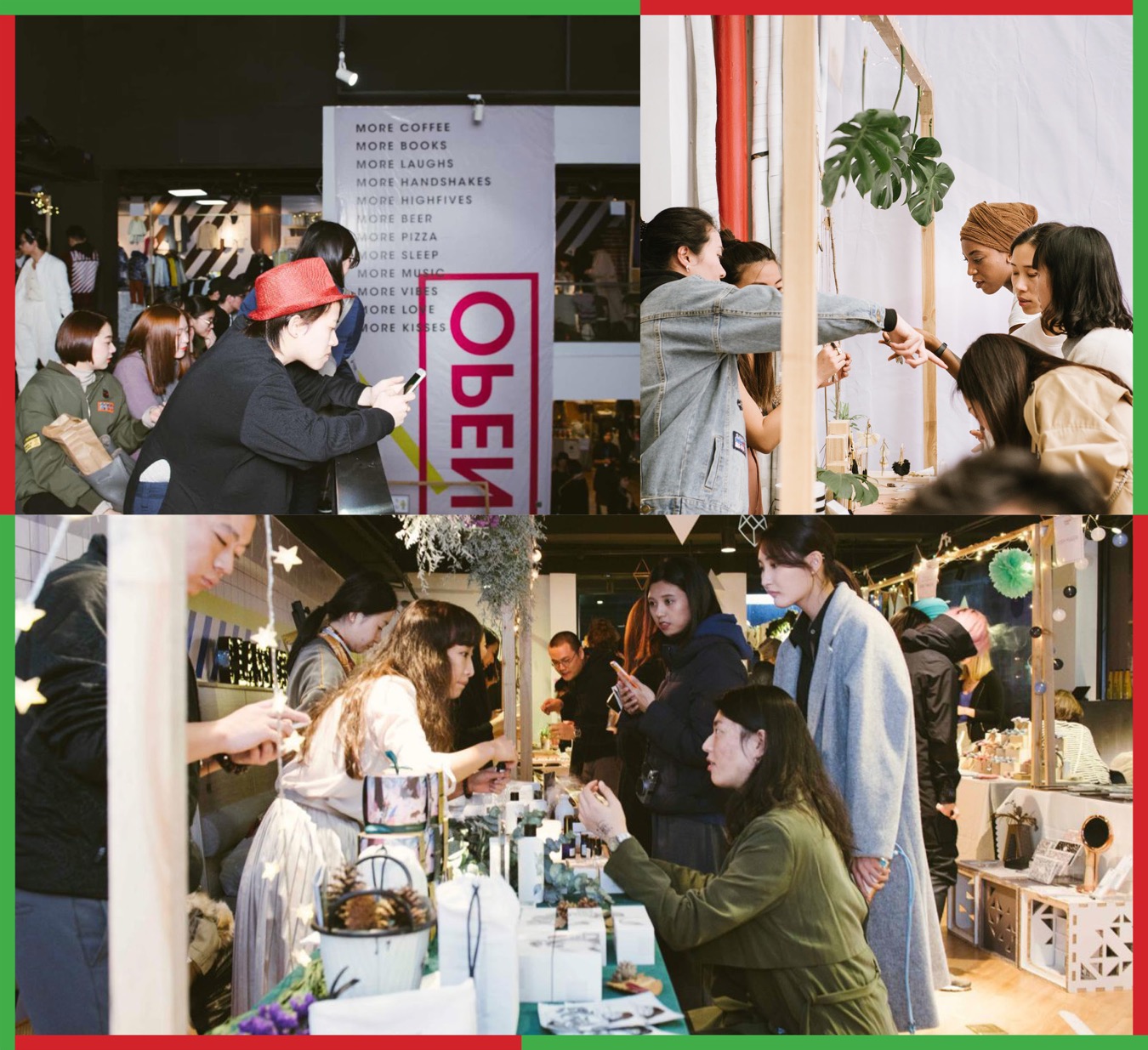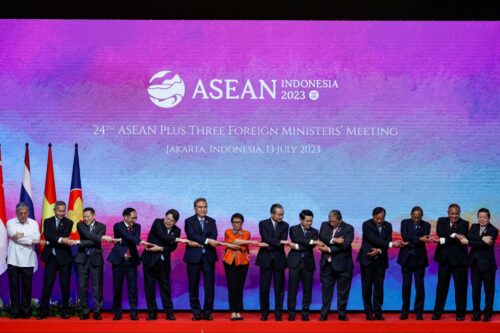‘Christmas markets’ in China aren’t merely seasonal, and not just for foreigners

On a top floor of Shanghai’s K11 mall, a few levels above glossy, luxury brand storefronts, a maze of tabletops display locally made jewelry, hand-knit scarves, and ceramics. Standing in one corner, occasionally tossing back plastic balls that have spilled out of an inflatable ball pit set up for children, Shanghai-based designer Kiki Zhu looks over her jewelry designs — earrings in the shape of the Chinese characters 喜, 怒, 哀, 乐 (love, anger, sadness, happiness) printed in bold primary colors on laser-cut plastic, and necklaces that pop with texture. A steady stream of Chinese and foreign customers wander past her booth, many who say they’ve come to the mall specifically for the Christmas Commune Market, one of at least half a dozen Christmas markets incorporating local artisans and independent designers happening across the city on this crisp Saturday afternoon.
Zhu, who would sell her jewelry at a live music house later that night, says that shopping independent brands in alternative settings is part of a new cultural outlook in urban China. “In previous generations, everybody dressed the same, listened to the same type of music, but now we have a concept of independence, individuality,” says Zhu, who calls her brand #Normal, a tongue-in-cheek suggestion that people’s differences make difference normal. “Everybody has their own style, and that means we can have independent designers and indie music. People will pay for something that’s handmade.”
This culture is particularly visible at Christmastime in China’s major international hubs, when multiple holiday-oriented markets are running over a period of several weeks in Shanghai and Beijing. But the trend isn’t merely seasonal. Markets showcasing independent and artisan brands, including the Commune Market, pop up at venues such as malls and restaurants and event spaces year-round. Many markets are imports from foreigners living in China, rooted in the well-established Western culture of shopping independent and artisan culture. Yet many young, middle-class Chinese, who are increasingly interested in shopping independently designed and artisan products, have also latched on.
“There’s a definite shift in buying habits. Chinese customers are striving for something unique, and there’s more value in the handmade,” says Liuba Vladimirova, who runs the Beijing Flea Market, a quarterly market featuring mostly China-based foreign designers and artisans. In the five years that she’s been involved in the Beijing market scene, Vladimirova, who is also an illustrator, has seen growth in both the number of markets in Beijing as well as interest from Chinese shoppers in their twenties and thirties. “It’s very interesting to see how it’s changing.”

For the minority?
Shanghai’s lively market scene, with different events happening each month, is partly why independent designer Duffy Xu from Hainan brought her brand Duffy&Koala to Shanghai, explaining that it’s the best way for her to connect with customers. “The motto of my brand is ‘for the minority.’ It’s a niche group of people who are interested in my products,” says Xu, who sells her accessories, which combine recycled materials like wine corks with hardware and other materials, in the midst of a lively, mulled-wine-fueled Christkindlmarkt German holiday market. “But at markets, I can talk to a wide range of different people who come, exchange ideas and stories, and also show them how to style my products.”
The desire to cultivate social connections between designers, artisans, and customers inspired Vivian Sze and Tiffany Wong to begin a Shanghai-based lifestyle company called Common Rare, which hosts curated events with around 50 local artisans and independent designers every few months in Shanghai. As Americans who grew up in Shanghai before studying in California, they are well versed in the flourishing West Coast market culture. They recognized an opportunity in Shanghai to launch the kind of markets found in Los Angeles.
“When I was in college, I’d come home and look for [this culture], but I didn’t see it happening. Now in the past two to three years, it’s starting to grow,” says Sze, who started Common Rare last year. She believes that the trend will only continue, as young people are less and less interested in shopping mall fashion, and instead seek shopping experiences where they can look at and touch creative designs. (And take selfies, of course.) The majority of their markets’ attendees are local women in their twenties and thirties, Sze says.
While there is a distinct, expanding appetite for independent brands among upwardly mobile and internationally minded young Chinese, it’s unclear to what extent these consumer habits will spill into the mainstream.
“Chinese customers aren’t used to this type of shopping,” says Aileen Chen, who recently left her big-business consulting job to help independent and craft businesses with the branding and marketing aspect of their operations. It’s a consulting niche with multiple challenges, she explains: guiding a new wave of independent businesses not only to understand branding, but also to how they can use it to connect with a skeptical consumer.
“Getting consumers to trust the brand is a practical challenge,” says Chen, who also runs her own artisanal side business. “They don’t trust the brand and the quality if they have never heard of it or have any information about it.”

The kids are all right
China’s steadily growing appetite for fashion is somewhat of a double-edged sword when it comes to market culture. On the one hand, mainstream luxury fashion rules the day: In 2016, 7.6 million Chinese households bought luxury goods, amassing about $7.4 billion in spending, according to McKinsey data. This means China alone occupies almost a third of the global luxury market.
It also means that global luxury brands need to keep those customers engaged and shopping at China’s massive and numerous luxury malls. “Mall culture is still pretty hot here, developers still want to open malls because consumers keep going,” explains Timothy Parent, founder of China Fashion Bloggers. He notes that the Starbucks Reserve Roastery in the newly opened HKRI Taikoo Hui Mall in Shanghai represents part of the perpetual one-upmanship that happens at commercial shopping centers.
But at the same time, that buying power and interest in fashion appears poised to buoy the growing success of independent designers, especially as the market continues to mature. “Young people allocate their wealth differently in China because they are not spending on student debt, and they have all these assets from their parents,” Parent explains. “Even though the GDP per capita is still lower in China than in the U.S., their disposable income is greater. Everybody is basically in a trading-up phase, and so a lot of people are buying better — independent designers can offer really high quality, so consumers will turn to them instead of fast fashion or Taobao brands.”
Xu, of Duffy&Koala, is also bullish on the effects of China’s fashion boom, but for a different reason. “Today’s kids are brought up in such a fashionable way, surrounded by all these influences in the city,” she says, noting that even children and teen customers are interested in her accessories. “This makes me optimistic about the future of creative design and style.”






